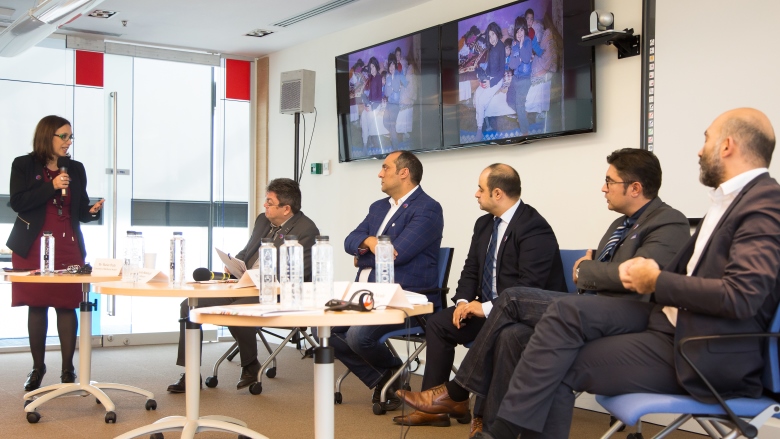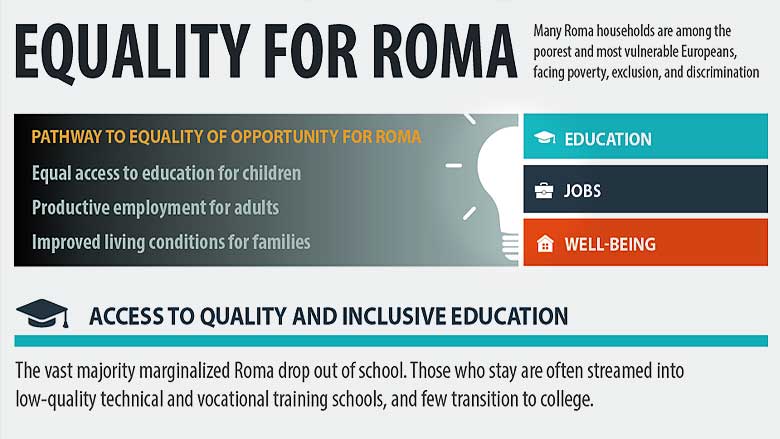Your Excellencies,
Dear Researchers,
Distinguished Guests and Colleagues,
It is a privilege to welcome you today at the official launch of the Scholarship Program on Roma Slavery Studies, the first such program in Romania. I am extremely pleased to greet Adrian and Mihai, two of the scholarship recipients of this wonderful initiative, and wish them great success as they embark on the study of Roma history.
The Foundation for Community Development “Impreuna Agency” and Romano Butiq Association have initiated this academic research scholarship program on Roma Slavery Studies. I would like to congratulate Gelu Duminica and Nicoleta Bitu for this great initiative.
For the World Bank Group, this scholarship program focused on the study of Roma history and heritage represents a unique moment. Our activities in Romania focus on addressing Roma exclusion. Our analytical research is unambiguous in arguing that Roma inclusion is smart economics.
The World Bank Group – in a joint cooperation of IBRD and IFC – is proud to support financially this scholarship program along with other sponsors – private companies, the Embassy of the Kingdom of Sweden, the Embassy of the United Kingdom, the producers of “Aferim” movie and other generous persons.
This combined effort will support the study of Roma heritage and history that can contribute in a meaningful way to promote a better understanding of Roma issues and a more inclusive society. Our event today represents more than the launch of a scholarship program on a new area of study in Romania. It represents a celebration of the power of education, professional excellence and social inclusion.
Education is one of the pillars of ending extreme poverty in the world as it has the potential of being one of society’s greatest “equalizers”. There is strong evidence that investing early in young children increases their capacity to learn when they enter primary school. In turn, this improves their chances of remaining in school rather than dropping out, and of moving on to secondary education. In the long run, it also considerably boosts their earning potential as adults.
In Romania about 42 percent of the population is at risk of poverty or social exclusion and one in five Romanians is income poor. Many of these people in poverty are Roma. Roma have a 10 times higher risk of being poor than the general population regardless of their age, education, or area of residence. In 2013, for example, 33 percent of Roma were in absolute poverty while only 3.4 percent of non-Roma were below the poverty line. The difference between Roma and non-Roma does not change significantly whether the individuals live in rural or urban areas. 90 percent of Roma households face severe material deprivation compared to 54 percent of non-Roma neighbors. What is worrying is that the poverty risk is extremely high for Roma children. Their poverty rate is 37.7 percent compared to a national rate of 4.3 percent.
The social and economic inclusion of Roma is essential if Romania is to meet its Europe 2020 targets and achieve EU convergence. Whilst the Romanian population is aging and shrinking, the Roma cohort is young and growing. Between 6-20 percent of new labor market entrants in Romania are Roma. Therefore, ensuring equal opportunities for Roma is not just a moral and social imperative, it is also an economic necessity.
The circumstances in which children are born and raised shape their life-long opportunities. I would like to highlight how inequalities impact education and employment outcomes.
Inequalities for many Roma start early in their lives and perpetuate over generations. Approximately 40 percent of children in Roma households, in Romania, are undernourished. They have a poor diet and inadequate access to housing, health, water and sanitation services.
Poor access to education is a major limitation to achieving the same development outcomes. Only 37 percent of Roma children between 3 and 6 years of age are enrolled in preschool, undermining school readiness of Roma children and their chances of achieving higher educational levels and employment skills later in life. Only 12 percent of Roma men and 6 percent of Roma women complete secondary school, and less than 5 percent of Roma have post-secondary education. It is not surprising that illiteracy is prevalent in marginalized Roma communities.
Almost half of Roma households in Romania have low levels of employment. Less than 19 percent of Roma women and 42 percent of men are employed, many as unskilled laborers, with direct impact on their poverty status. Roughly 35 percent of Roma employment is formal. Employed Roma earn only a fraction of the average earnings of the general population. Labor income of working-age Roma men in Romania is estimated to be only 20 percent of that of the general population. The corresponding figure for Roma women is 12 percent. The economic benefit of an increase in the average productivity of Roma up to the level of non-Roma is estimated at 3-4 percent of Romania’s GDP. It is for this very reason that the inclusion of Roma in the labor market is smart economics.


